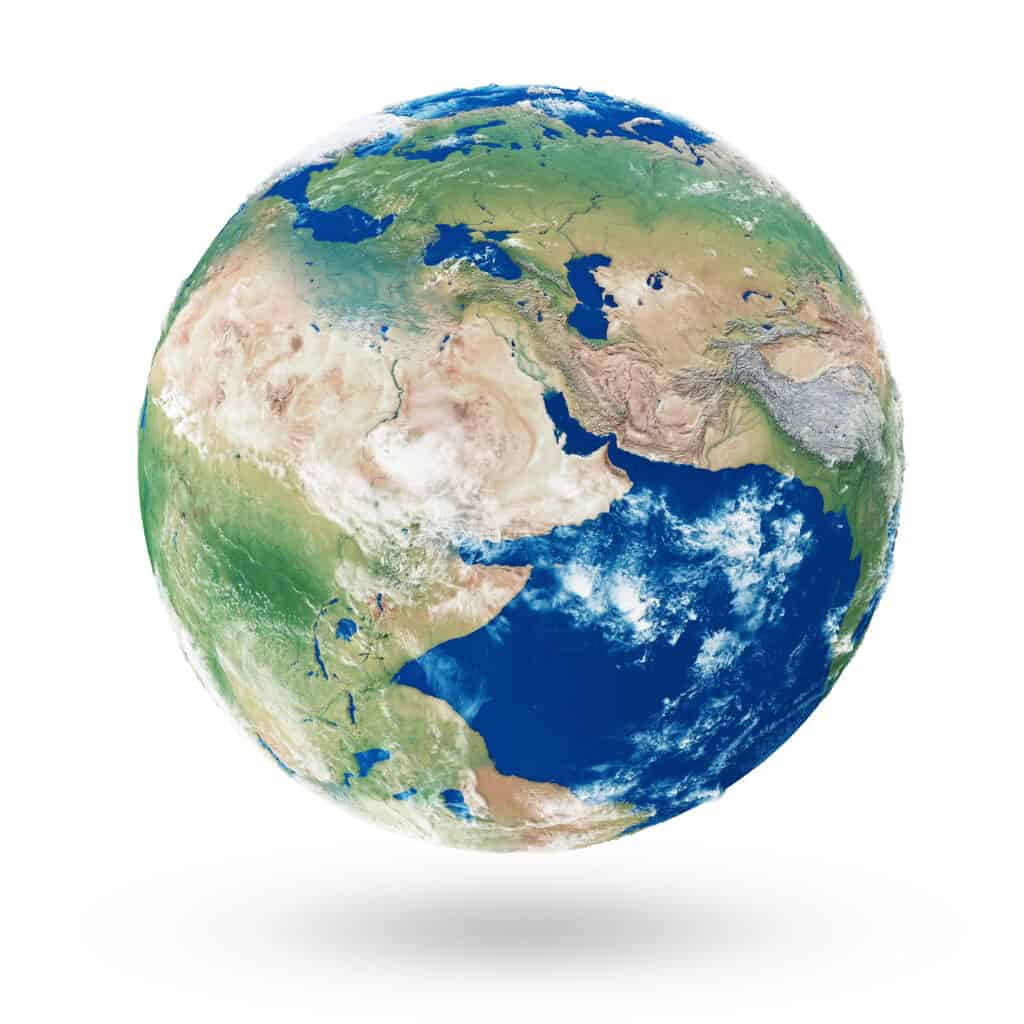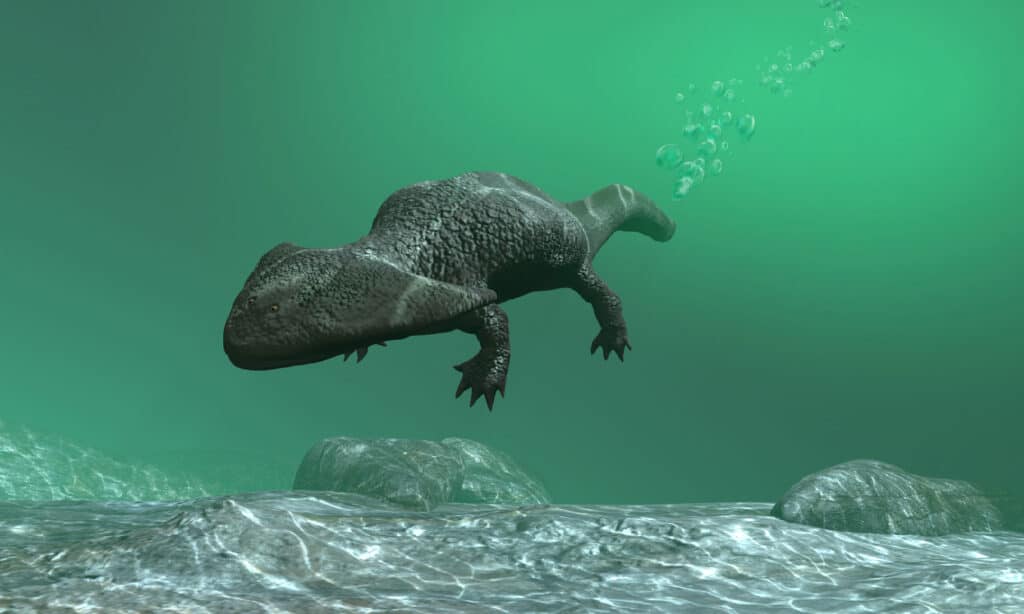The Permian Period was the last period of the Paleozoic Era. It is famous for the worst extinction ever in earth’s long history. The Permian Period commenced 298.9 million years ago and ended 252.2 million years ago. Roderick Murchison named the period in 1841 in collaboration with Russian geologists. The name represents beds of rocks lying above carboniferous layers that were quite common in the city of Perm in the Ural Mountains of Russia. This article discusses the timeline of the Permian Period, the major events, the climate, as well as the plant and animal life.
Timeline of the Permian

Many Permian period rocks are characterized by their red appearance
©LETOPISEC/Shutterstock.com
The Permian lasted for about 47 million years from the end of the Carboniferous to the beginning of the Triassic Period. It was the last duration of the Paleozoic, and it ushered in the Mesozoic Era.
Scientists often divide the Permian into three epochs. These are the Cisuralian epoch, Guadalupian and Lopingian. The oldest of these is the Cisularian which started 298.9 million years ago and ended around 283.5 million years ago. The Cisuralian was followed by the Guadalupian epoch, which lasted until 265 million years ago. The last of the Permian epochs is the Lopingian.
Major Events of the Permian Period
The Permian Period was an important crossroad in the planet’s history. Two major events occurred during the Permian that shaped the period and altered life on earth permanently. These two events are the formation of Pangea—a supercontinent that lasted from the late Paleozoic to the early Mesozoic—and the mass extinction event at the end of the Permian.
Formation of Pangea — 299 Million Years Ago

The formation of the supercontinent Pangea was one of the major events during the Permian Period.
©Rashevskyi Viacheslav/Shutterstock.com
One of the most significant events of the Permian Period was the formation of the Pangea supercontinent. Before this time, most of earth’s landmasses (Africa, India, South America, Madagascar, Antarctica, and Australia) had collided to form Gondwana. Later as the Permian progressed, this single northern landmass collided with southern Laurussia (also known as Euramerica).
The formation of Pangea was eventually completed by the middle of the Permian. The massive continent, which stretched from the north to the south pole, was surrounded by a single ocean known as Panthalassa. There was also a small prehistoric sea on the east known as Tethys.
Permian Extinction — 251 Million Years Ago

Trilobites were just one of the many species of animals which became extinct during the Permian Period.
©iStock.com/Aunt_Spray
The Permian Period is highly memorable for the greatest extinction in history that occurred later in the period. This extinction was so severe that only 10 percent or less of the species present during the Paleozoic era survived into the next era. There is still a lot of debate as regards the exact timing of the extinction, and as a result, there is no universally acceptable time frame.
There is a general agreement, however, amongst scientists that the extinction exterminated about 95 percent of marine species and 70 percent of land species. Many geological professionals and paleontologists agree that the Permian extinction was a two-fold event that happened during the late period of the middle Permian and throughout the late Permian—over 15 million years. Others argue that it took only 200,000 years. Scientists also have differing beliefs with regards the factors that triggered the extinction.
Research findings show that the mass extinction was caused by global warming, which greatly affected the survival of the animal species. Scientists believe volcanism may have contributed extensively to climate change at the end of the Permian. The eruptions would have released considerable amounts of volcanic ash and carbon dioxide into the atmosphere, causing widespread global warming.
Climate of the Permian Period
The Permian climate began cool and humid but transitioned into warm and arid by the end of it. An ice age characterized by extensive glaciation had begun during the Carboniferous period and dragged into the early stage of the Permian Epoch. The glaciation affected vast areas of southern India, Antarctica, Australia, and northeastern Siberia. However, by the Middle Permian, the climate began to warm up, ending with hot and dry deserts in tropical and subtropical areas in Late Permian.
The conjoining of the smaller continents into the large continent of Pangea triggered arid weather conditions. Substantial mountain-building events occurred as a result of these collisions. The creation of high mountain ranges influenced local and regional terrestrial temperatures.
In addition to the effects of the new mountain ranges being formed, volcanism may have also contributed to the climate towards the end of the Permian. Scientists have noted an abundance of Siberian flood basalts, which may have erupted about 250 million years ago. This volcanic event probably lasted for about 600 years, releasing large amounts of volcanic ash into the air. This got in the way of photosynthesis, impeding the rate plants that took up carbon dioxide and eventually caused the planet to warm up over the years.
Plant and Animal Life

Helicoprion bessonovi – edestid “shark” from Early Permian (Artinskian) of the Ural region. There were many unique animals that lived during the Permian Period.
© – License
Increasing temperatures throughout the Permian Period triggered a rapid diversification of organisms. The Permian flora and fauna included marine and terrestrial plants, insects, as well as the ancient ancestors of modern-day mammals, reptiles, and birds.
Plant Life
A surge in terrestrial plant life provided an important food source for many land animals. Glossopteris, an extinct plant with tongue-shaped leaves, was prominent during this period. The evolution of arthropod herbivores and vertebrate carnivores brought about plant development in new directions.
Fossil plant records of the early Permian include ferns, seed ferns, and lycophytes, adapted to marshes and swampy environments. The mid-Permian Period consisted of vascular plants like proto angiosperms and neophytes that adapted to the areas getting dry over some time.
Insects
The increase in plant life accelerated the subsequent increase in insects. Insects first appeared during the Carboniferous Period, and their population increased gradually. However, the Permian is characterized by a dramatic increase in its diversification. This eventually slowed down towards the end of the Permian, and many of the dominant insect groups from the Permian began to disappear. Many of the present-day insect groups evolved during the Permian as well.
Terrestrial Animals

The Dimetrodon had elongated spines extending from its vertebrate.
©Dziurek/Shutterstock.com
The synapsids and the sauropsids were mostly dominant during the Permian. Both groups evolved from the basal amniotes that had been dominant during previous periods. Synapsids are the ancestors of mammals, while the saurospids gave rise to today’s reptiles and birds.
One major synapsid that was popular during the Permian was Dimetrodon. Many believe that Dimetrodon was the ancestor of dinosaurs. In reality, it possessed more mammalian characteristics and became extinct 40 million years before the dinosaurs first appeared on earth.
Fossil records denote that synapsids were more dominant than saurospids, but sauropsids could withstand and adapt to the severe circumstances that characterized the extinction. Not only did they survive the Permian extinction, but their population also increased after the event. Saurospids are the ancestors of present-day reptilians.
Marine Life

Diplocaulus lived from the Late Carboniferous to the Late Permian of Africa and North America.
©iStock.com/estt
As regards marine life, little is known about life within the deepest parts of the panthalassic ocean because many fossils are buried deep beneath the ocean. However, experts think the marine life of the Permian was most likely more diverse than what we currently have in modern oceans.
The most common marine animals were cartilaginous fish, brachiopods, bryozoans, ammonites, and true bony fishes. Reefs were vast, and there was diverse life within those reefs. Reptiles flourished on land and within the waters, while amphibians and therapsids also flourished during this era.
Up Next
- When Dinosaurs Go Extinct?
- Discover the Ancient Salamander So Odd Scientists Aren’t Sure How to Classify It
- The 6 Largest Extinction Events on Earth and When They Occurred
The photo featured at the top of this post is © LETOPISEC/Shutterstock.com
Sources
- Britannica, Available here: https://www.britannica.com/science/Permian-Period
- Live Science, Available here: https://www.livescience.com/43219-permian-period-climate-animals-plants.html
- Berkeley, Available here: https://ucmp.berkeley.edu/permian/permian.html
- Humboldt, Available here: https://natmus.humboldt.edu/exhibits/life-through-time/visual-timeline/permian-period
Thank you for reading! Have some feedback for us? Contact the AZ Animals editorial team.







